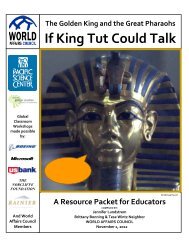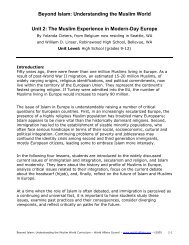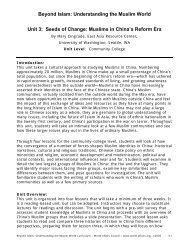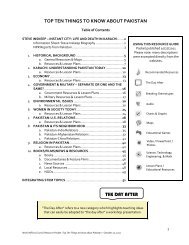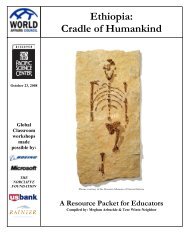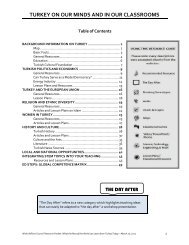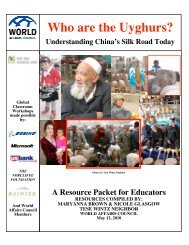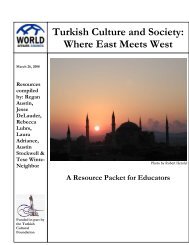The Japanese Approach to Environmental Issues - World Affairs ...
The Japanese Approach to Environmental Issues - World Affairs ...
The Japanese Approach to Environmental Issues - World Affairs ...
You also want an ePaper? Increase the reach of your titles
YUMPU automatically turns print PDFs into web optimized ePapers that Google loves.
Meeting Needs and Wants: U.S. and <strong>Japanese</strong> Transportation Innovations in the 1950s and 1960sWASHINGTON STATE CBA (CLASSROOM-BASED ASSESSMENT):MEETING NEEDS AND WANTS<strong>The</strong> Meeting Needs and Wants CBA states:“As a citizen and member of a community, you need <strong>to</strong> have an understanding of differenteconomic systems. You will analyze the methods that societies use <strong>to</strong> meet the economic needs andwants of citizens.”What does the CBA require students <strong>to</strong> do?1) Describe examples of how two societies have met their needs and wants.2) Explain how both societies’ rights, values, and/or beliefs have affected their economicchoices.3) Compare and contrast the two groups’ economic choices citing specific similarities anddifferences.4) Show a thorough understanding of opportunity cost through explanation and analysis.Note: <strong>The</strong> position statement may take any of a variety of forms, e.g., essay, letter <strong>to</strong> the edi<strong>to</strong>r orpolitician, journal entry, or newspaper article. In addition, students’ in-class presentations may takeany of a variety of forms, e.g., PowerPoint, theater, board games, models, videos, car<strong>to</strong>on series,speech, or multi-media presentation.<strong>The</strong> graphic organizer and scoring rubric for this CBA which appear at the end of this document arealso available at the OSPI website.OSPI’s instructions for teachers and students: Washing<strong>to</strong>n State Social Studies CBA Meeting Needsand Wants: http://www.k12.wa.us/assessment/WASL/SocialStudies/default.aspxHISTORICAL BACKGROUND FOR TEACHERSBeginning in 1868 in the Meiji period, the <strong>Japanese</strong> Empire built up a strong, industrializedeconomy. During <strong>World</strong> War II (also known as the Pacific War) Japan’s economy was destroyed bymilitary attacks, use of scarce resources for military purposes, and severed trade relations. Transportwas nearly impossible, and urban industrial production halted. During the U.S.-led occupation ofJapan from 1945 <strong>to</strong> 1952, the Allies democratized Japan’s political system and liberalized itseconomic system. When they attempted <strong>to</strong> dismantle the <strong>Japanese</strong> zaibatsu (conglomerates), the<strong>Japanese</strong> resisted on grounds of international competition; looser industrial groupings, known askeiretsu, evolved. Under the leadership of Prime Minister Ikeda (1960-1964), the <strong>Japanese</strong>government under<strong>to</strong>ok an ambitious "income-doubling plan." Ikeda’s government rapidly expandedgovernment investment in Japan’s infrastructure: building highways, high-speed railways, subways,airports, port facilities, and dams.In the U.S., the post-war economy was very strong, allowing the country <strong>to</strong> focus on meeting itswants as well as its needs. Consumer goods, such as cars and televisions, were in high demand asaffluent Americans moved <strong>to</strong> the suburbs. As the U.S. looked back on WWII and entered the ColdWar, President Dwight D. Eisenhower pushed for the National Interstate and Defense HighwaysAct of 1956, a plan inspired by the German au<strong>to</strong>bahn network. In addition <strong>to</strong> facilitating transpor<strong>to</strong>f civilians and consumer goods, it would provide key ground transport routes for military supplies3



